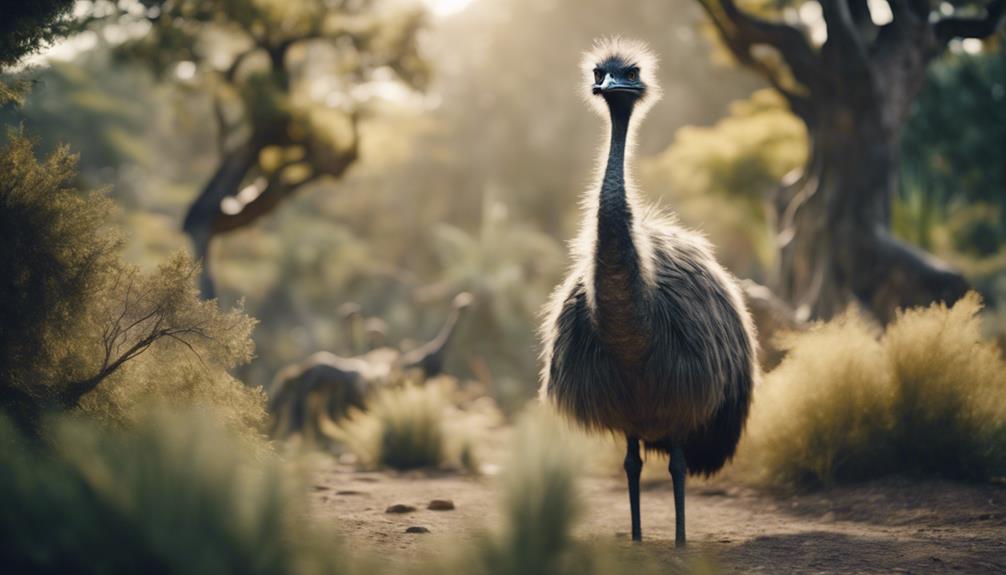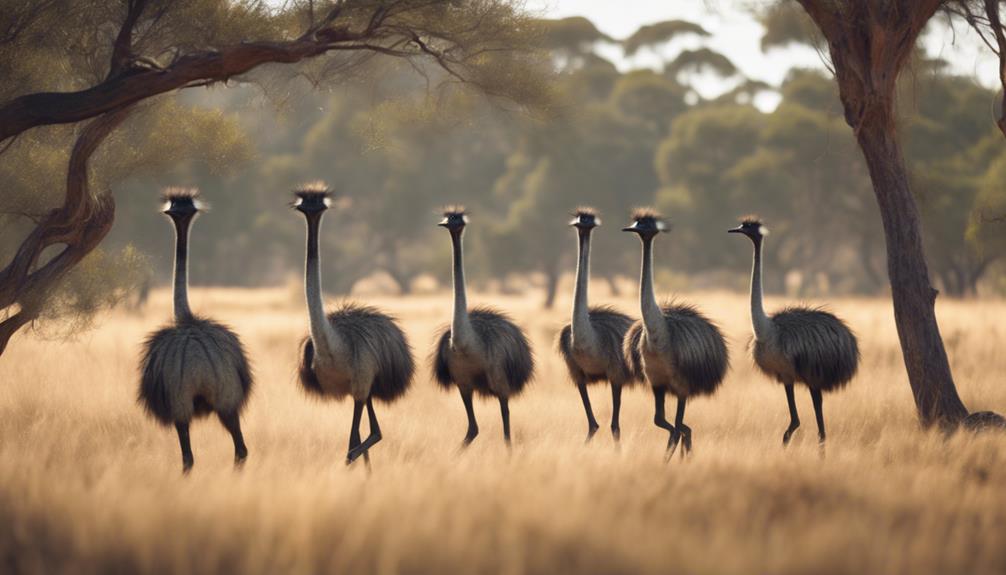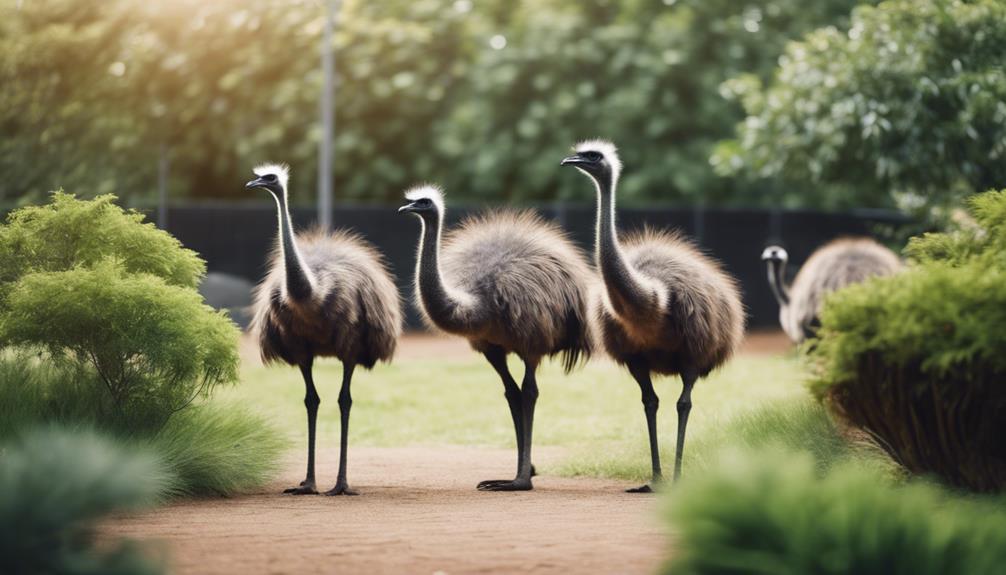
Imagine a vast, sun-kissed landscape where emus roam freely, their long legs carrying them gracefully across the red earth. As you start exploring the captivating history of these enigmatic creatures, you'll uncover tales of resilience, cultural significance, and unexpected encounters that have shaped their place in the annals of Australia. From ancient connections with Indigenous peoples to their surprising role in historical events, the story of emus is a tapestry woven with threads of mystery and intrigue, beckoning you to unravel its many layers.
Key Takeaways
- Emus' evolutionary journey spans millions of years.
- Emus hold spiritual significance in Indigenous Australian culture.
- Historical encounters with emus influenced European perceptions of Australia.
- Emus symbolize resilience, adaptability, and independence.
- Conservation efforts aim to address threats like habitat loss and predation.
Origin of Emus

Emus originated in Australia, primarily inhabiting the continent's diverse landscapes. These flightless birds belong to the ratite family, characterized by their long legs and necks. Renowned for their adaptability, emus thrive in various environments, from dense forests to arid plains, showcasing their resilience and dominance in the Australian ecosystem.
Their evolutionary journey traces back millions of years, showcasing their ability to withstand changing climates and outlast other species. Emus have perfected the art of survival, utilizing their powerful legs for swift running and their keen senses for detecting danger. This has allowed them to establish themselves as formidable creatures in the Australian wilderness.
Despite their seemingly awkward appearance, emus are well-adapted for their environment, with their sharp beaks used for foraging and their unique feather structure aiding in temperature regulation. Understanding the origins of emus provides insight into the intricate balance of nature and the remarkable adaptations that have allowed these majestic birds to reign supreme in the Australian landscape.
Indigenous Australian Connection
How do the Indigenous Australians connect with the emus in their environment? The emu holds a significant place in the culture and survival of Indigenous Australians, showcasing a deep connection to the land and the natural world. Here are some key ways in which this connection is manifested:
- Spiritual Significance: Emus are often considered sacred animals in Indigenous Australian spirituality, symbolizing strength, resilience, and wisdom.
- Hunting and Food Source: Emus have been a vital source of food for Indigenous communities for thousands of years, providing sustenance through their meat and eggs.
- Art and Storytelling: Emus feature prominently in Indigenous art and Dreamtime stories, reflecting their cultural importance and the traditional knowledge associated with them.
- Environmental Awareness: The presence and behavior of emus in the environment serve as indicators of changing seasons and environmental conditions, guiding Indigenous practices and rituals.
Through these multifaceted connections, the emu continues to play a crucial role in the lives and traditions of Indigenous Australians, symbolizing a profound bond with the natural world.
Emus in Early European Encounters

Indigenous Australian reliance on emus as a food source and their spiritual significance set the stage for the interactions with early European encounters, shaping perceptions and exchanges in significant ways.
When European explorers first encountered emus in the late 18th century, they were struck by the sheer size and unique appearance of these flightless birds. Emus were initially seen as a valuable food source due to their large size and abundance in the Australian landscape. However, as Europeans attempted to hunt emus for sustenance, they found the task to be more challenging than anticipated due to the bird's speed and agility. This led to a deeper respect for the emu's survival skills and adaptability in the harsh Australian environment.
The encounters with emus also influenced European perceptions of the Australian continent, shaping early colonial attitudes towards its wildlife and resources. Emus played a crucial role in the cultural exchange between Indigenous Australians and early European settlers, highlighting the complexities of intercultural interactions during this period.
Emus in the 1932 Great Emu War
The 1932 Great Emu War, a notable event in Australian history, saw military intervention against a sizeable emu population causing agricultural havoc. The Australian military was called upon to deal with the emu infestation that was destroying crops and impacting farmers' livelihoods. Despite their efforts, the emus proved to be a formidable adversary, outmaneuvering the soldiers and causing significant challenges in their eradication.
- The emus' agility and speed made them difficult targets for the military.
- The vast open landscapes of Australia provided the emus with ample space to evade capture.
- The soldiers' firearms weren't always effective in dealing with the resilient emus.
- The persistence and adaptability of the emus showcased their ability to withstand human intervention.
Emus in Australian Folklore

Emus hold a significant place in Australian folklore, embodying tales of resilience and adaptability passed down through generations. These majestic birds are often depicted in Aboriginal Dreamtime stories as clever and resourceful beings who outsmart other animals with their cunning ways. In more modern folklore, emus symbolize the spirit of the Australian outback, representing endurance and strength in the face of adversity.
One popular folktale recounts the story of how emus, with their swift speed and keen intelligence, managed to evade capture by early settlers, becoming a symbol of freedom and untamed wilderness. Another tale speaks of the legendary 'Emu in the Sky,' a constellation that's said to watch over the land and its people, guiding them through the vastness of the Australian bush.
Through these stories, emus have become a revered symbol of resilience and adaptability in Australian folklore, showcasing the power and magnificence of these unique birds in the hearts and minds of the people.
Emus as National Symbols
Symbolizing endurance and strength, emus have been ingrained as significant representations in the national identity of Australia. These majestic birds have become powerful symbols that resonate deeply with the Australian people, embodying key values and characteristics that define the nation's spirit.
- Resilience: Emus are known for their ability to endure harsh environments and overcome challenges, symbolizing the resilience of the Australian people in the face of adversity.
- Independence: Emus are independent creatures that roam freely in the vast Australian landscape, reflecting the spirit of independence and freedom cherished by Australians.
- Unity: The image of emus standing together in a group highlights the importance of unity and solidarity in Australian society, emphasizing the strength that comes from standing together.
- Legacy: Emus hold a historical significance in Australia, with their presence in various cultural and historical references serving as a reminder of the country's unique heritage and identity.
These elements combined make emus a compelling national symbol that embodies the essence of Australia's identity and values.
Emus in Modern Conservation Efforts

Playing a pivotal role in contemporary conservation initiatives, emus actively contribute to the preservation of Australia's unique biodiversity. These iconic birds play a crucial part in maintaining the delicate ecological balance of their habitats. Here is a table showcasing the key ways emus contribute to modern conservation efforts:
| Contribution | Description | Impact |
|---|---|---|
| Seed Dispersal | Emus consume various fruits and seeds, aiding in seed dispersal across different regions. | Helps in the regeneration of plant species. |
| Habitat Maintenance | By foraging selectively, emus prevent the dominance of certain plant species, promoting biodiversity. | Ensures a healthy ecosystem for various organisms. |
| Pest Control | Emus feed on insects and small animals, helping control pest populations naturally. | Reduces the need for chemical pesticides in the area. |
Emus' role in modern conservation strategies underscores their significance in preserving Australia's rich biodiversity.
Emus in Popular Culture
Within the realm of popular culture, emus have garnered attention for their unique presence and influence in various forms of artistic expression and media. Emus have made their mark in the entertainment world, showcasing their intriguing characteristics and captivating audiences worldwide.
- Emus in Cartoons: These birds have been featured in animated series and movies, often portrayed for their quirky behavior and distinctive appearance.
- Emu-inspired Fashion: Designers have drawn inspiration from the emu's sleek feathers and striking color palette, incorporating these elements into high-fashion garments and accessories.
- Emus in Music: Some musicians have referenced emus in their songs, using the bird as a symbol of freedom, strength, or resilience.
- Emu Mascots: Emus have been adopted as mascots for sports teams and events, symbolizing agility, determination, and a competitive spirit.
The emu's presence in popular culture not only reflects its widespread recognition but also highlights the bird's symbolic significance in various creative outlets.
Emus in Zoos and Wildlife Parks

Emus can often be found in zoos and wildlife parks around the world, where visitors have the opportunity to observe these fascinating birds up close in their natural habitat. These facilities play a crucial role in educating the public about emus and their behavior. Zoos and wildlife parks create environments that mimic the natural habitats of emus, allowing guests to witness their distinctive characteristics firsthand.
In these settings, you can observe the emus' large size, powerful legs, and distinctive feathers. Zoos often provide informative displays about emus, detailing their diet, behavior, and significance in various ecosystems. Wildlife parks, on the other hand, offer a more immersive experience, allowing you to see emus roaming freely in spacious enclosures.
Moreover, zoos and wildlife parks contribute to conservation efforts by participating in breeding programs aimed at preserving emu populations. By visiting these facilities, you not only gain a deeper understanding of emus but also support initiatives that help ensure the survival of these magnificent birds for future generations to appreciate.
Emus in Literature and Art
In literature and art, emus have been depicted as symbols of resilience and freedom, capturing the imagination of creators across various mediums. Emus, with their distinctive appearance and unique behaviors, have inspired numerous works that delve into themes of strength and independence.
- Emus in poetry symbolize the endurance of the human spirit in the face of adversity.
- In paintings, emus are often portrayed as majestic creatures embodying the untamed wilderness.
- Sculptures of emus represent the untapped potential and boundless possibilities that lie within each individual.
- Emus featured in literature serve as metaphors for breaking free from constraints and embracing one's true nature.
Through these artistic representations, emus have become icons of determination and authenticity, resonating with audiences seeking to connect with their inner power and resilience. Artists and writers alike continue to draw inspiration from the majestic emu, weaving its essence into their creations to evoke a sense of empowerment and freedom.
Emus in Scientific Research

Scientific researchers have increasingly turned to studying the unique characteristics and behaviors of emus to gain valuable insights into various aspects of avian biology and behavior. Emus, with their large size, distinctive appearance, and intriguing social structures, offer a wealth of opportunities for scientific inquiry. One area of research focuses on the emu's remarkable adaptability to different environments, shedding light on how these birds have evolved to thrive in various habitats.
Studies have delved into the reproductive biology of emus, examining their breeding habits, nesting behaviors, and parental care strategies. By understanding these aspects, researchers can draw parallels to other bird species and gain a deeper understanding of evolutionary patterns.
Furthermore, emus' vocalizations and communication methods have intrigued scientists, leading to investigations into their complex vocal repertoire and social interactions. By decoding the meanings behind different calls and gestures, researchers aim to unravel the intricacies of emu communication and social dynamics.
Emus: Threats and Conservation Challenges
Facing a myriad of threats and conservation challenges, the future of emus is at a critical juncture, necessitating urgent action to safeguard their survival. Emus, iconic flightless birds of Australia, are confronted with various obstacles that endanger their existence.
- Habitat Loss: Rapid urbanization and agricultural expansion encroach upon emus' natural habitats, limiting their space to roam and forage.
- Climate Change: Shifts in climate patterns pose a significant threat to emus, impacting their food sources and nesting grounds.
- Predation: Introduced predators like foxes and feral dogs prey on emu chicks, reducing their survival rates.
- Human Interaction: Collisions with vehicles, illegal poaching, and disturbance by tourists disrupt emus' behavior and population dynamics.
Conservation efforts involving habitat restoration, predator control programs, public awareness campaigns, and research initiatives are imperative to ensure the long-term survival of these majestic birds. It's crucial to address these challenges promptly to secure a sustainable future for emus in their native environments.
Frequently Asked Questions
Do Emus Have Any Natural Predators in the Wild?
In the wild, emus face few natural predators due to their large size and speed. Their main threats include dingoes, eagles, and other birds of prey. Emus have evolved to be resilient against these predators.
Can Emus Fly and How Fast Can They Run?
Can emus fly? No, they cannot. However, they can run impressively fast, reaching speeds of up to 30 miles per hour. Their powerful legs and unique physique contribute to this remarkable ability.
What Is the Average Lifespan of an Emu in Captivity?
In captivity, emus typically live around 10 to 20 years. Proper care, diet, and living conditions are crucial for their longevity. Regular veterinary check-ups and a well-maintained environment can help ensure a healthy and extended lifespan for emus.
Are There Any Unique Medicinal Uses for Emu Products?
You may be surprised to learn that emu oil, often used topically, has been attributed with anti-inflammatory properties. This natural remedy is gaining attention for its potential benefits in skincare and pain relief.
How Do Emus Communicate With Each Other in the Wild?
Emus communicate in the wild through a variety of vocalizations, body language, and movements. They use deep drumming sounds to alert others of danger and high-pitched calls to maintain contact or show aggression.
Conclusion
In conclusion, the history of emus is a rich tapestry of resilience and cultural significance. These iconic birds have withstood the test of time, symbolizing the enduring spirit of the Australian outback.
Like a beacon of independence and freedom, emus continue to captivate hearts worldwide. Their legacy is a testament to their adaptability and survival skills, making them a symbol of strength and endurance in the face of challenges.




